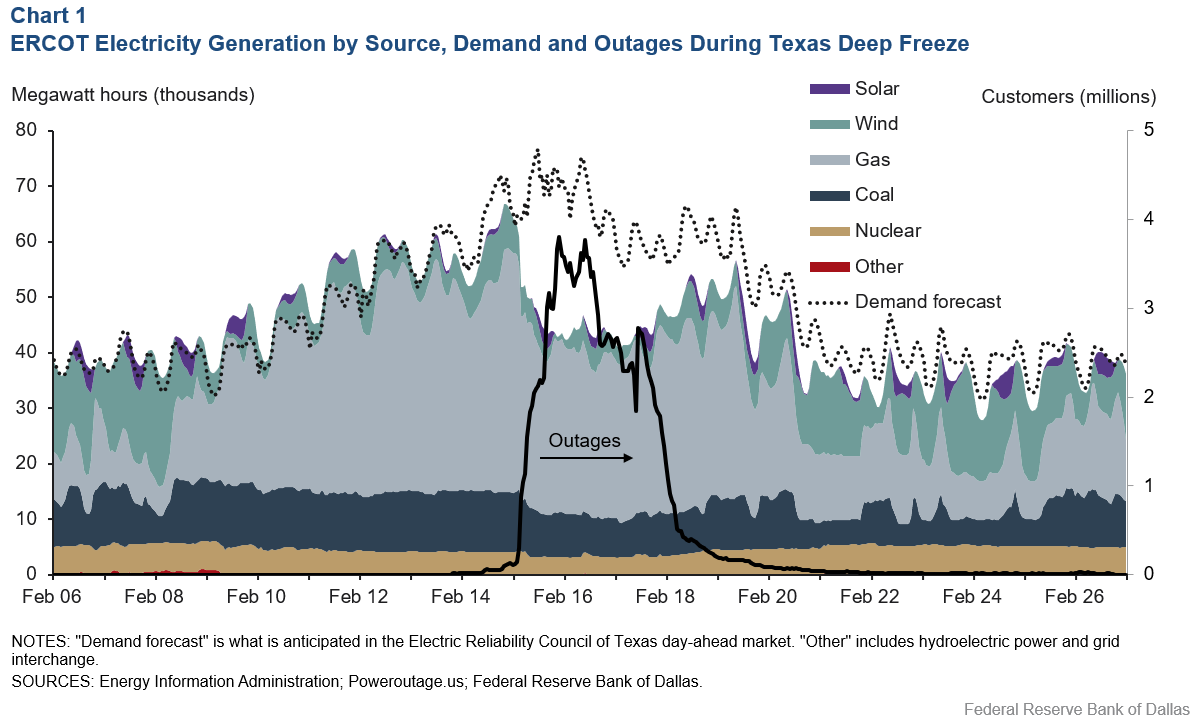
Cost of Texas’ 2021 deep freeze justifies weatherization
The energy value chain is a complex and interdependent mechanism. No single piece is the source of the devastating power outage that struck Texas during a record-breaking cold snap in mid-February.
Though the cost of annual preparations for extreme and relatively infrequent weather events has proven difficult for policymakers and industry to justify, the shocking aftermath of the February freeze and the resulting widespread power outage demand a careful re-examination. Our analysis indicates winterizing for extreme winter weather events appears financially reasonable.
Power generation fails to meet demand
A week before the storm, sustained wind speeds and mild temperatures allowed wind turbines to fill more than 50 percent of Texas power requirements. As wind speeds declined and the temperature plummeted, the grid increasingly relied on gas-fired power plants to meet mounting demand.
Temperatures dipped into the single digits and lower across much of Texas overnight on Feb. 14. Electricity demand surged as critical equipment failed at several power plants. Wind-farm output—already low due to diminished wind speeds—declined further as ice accumulated on turbine blades. Electricity generation declined yet again when gas-fired power plants were unable to procure needed gas supplies. Nearly 4 million Texas customers—representing more than 11 million people—lost power during the Arctic blast (Chart 1).

While industry sources report gas production difficulties occurred because of wells and other such installations freezing, the bigger disruption began when power was cut to the wells, processing plants and compressor stations that move the gas into and along major pipelines serving power plants. During the storm, 38 of Texas’ 176 gas processing plants shut down due to weather conditions and electricity service disruption. Texas natural gas production dropped 45 percent Feb 13–17.
This created a death spiral for electricity generation.
Calculating the storm’s cost
The power outages led to widespread damage to homes and businesses, foregone economic activity, contaminated water supplies and the loss of at least 111 lives. Early estimates indicate that the freeze and outage may cost the Texas economy $80 billion–$130 billion in direct and indirect economic loss. These initial calculations come with significant uncertainty. Estimates of insured losses, which are easier to quantify, range from $10 billion to $20 billion.
Power industry experts often rely on an indirect metric for the economic value of uninterrupted power—the value of lost load (VOLL). An estimate of VOLL for firms can be obtained by measuring the value of lost output using a production function approach that treats electricity as an intermediate input to production.
Data on gross domestic product, electricity consumption and retail prices for 2019 produce an average VOLL of $6,733 per megawatt hour (MWh) for firms and $117.60 per MWh for households. The total duration of load shed during the mid-February freeze was 70.5 hours, with an average load shed close to 14,000 MW. The amount of power lost along with VOLL estimates suggest the power outage cost $4.3 billion.
Cost of preventive measures varies
Because every source of power generation failed during the storm, measures that might avoid future disruptions have ranged from winterization of power plants to addressing the efficacy of intermittent renewable generation.
Winterizing standards on new oil and gas wells may offer a targeted and effective approach in the long run. Due to the high initial productivity of shale wells, new wells will eventually make up a large share of overall production. Many companies already implement winterizing measures. With winterizing equipment costing between $20,000 and $50,000 per well, we estimate these measures statewide would total $85 million–$200 million annually.
A large and perhaps inexpensive fix would be prioritizing electricity delivery to gas infrastructure. If power plant and pipeline operators improve coordination to identify and constantly monitor the gas infrastructure requiring such prioritization, some of the problems experienced during the freeze could be prevented.
Lawmakers are evaluating requirements for power plants to winterize. This topic was examined after a Texas winter weather event and power outage in 2011 that resembled the 2021 storm in many ways. No laws were passed a decade ago making winterization measures mandatory.
The Federal Energy Regulatory Commission (FERC) and North American Electric Reliability Corp. (NERC) determined in a joint study of the 2011 outage that winterizing equipment for Texas gas plants could cost between $50,000 and $500,000 (in 2011 dollars) per plant. Assuming these cost estimates remain valid and adjusted for inflation, installing FERC’s/NERC’s recommended equipment on all 162 gas-powered plants in Texas could cost up to $95 million today.
Winterizing Texas’ 13,000 wind turbines carries other challenges. Blades with internal warming equipment installed at the factory can cost $400,000 per unit; retrofits to existing turbines would be infeasible. However, upgraded blade coatings, cold-weather lubricants and de-icing drones would mitigate ice formation in most instances at lower cost.
Wind power will remain an intermittent power source until adequate battery storage technology is developed. The Texas power grid is designed to seamlessly take on gas and coal generation when wind output declines. This is proving a larger challenge every year as more wind capacity is installed.
However, in a hypothetical scenario of the February storm where all of Texas’ wind capacity is replaced by gas-powered plants, outages could still occur, though for shorter duration. This is because of these plants’ rate of failure due to the cold and to gas delivery problems (Chart 2).

Economically justified measures
Though the total cost of the winter storm could exceed $100 billion, the costs of winterizing electricity production should be viewed within the perspective of value of lost load. Using our VOLL estimate of $4.3 billion, and accounting for the once-a-decade frequency of subzero temperatures in Texas, winterizing measures and other actions should be equal to or less than $430 million annually.
Based on our analysis, the most reasonable solutions to prevent winter storm blackouts are within the bounds of being economically justified.





